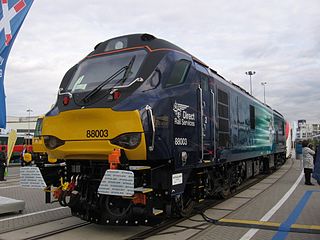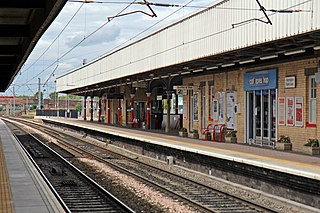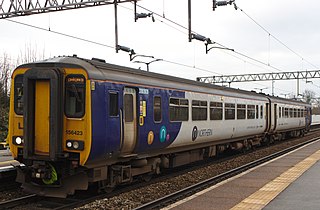
The West Coast Main Line (WCML) is one of the most important railway corridors in the United Kingdom, connecting the major cities of London and Glasgow with branches to Birmingham, Liverpool, Manchester and Edinburgh. It is one of the busiest mixed-traffic railway routes in Europe, carrying a mixture of intercity rail, regional rail, commuter rail and rail freight traffic. The core route of the WCML runs from London to Glasgow for 399 miles (642 km) and was opened from 1837 to 1869. With additional lines deviating to Northampton, Birmingham, Manchester, Liverpool and Edinburgh, this totals a route mileage of 700 miles (1,127 km). The Glasgow–Edinburgh via Carstairs line connects the WCML to Edinburgh. However, the main London–Edinburgh route is the East Coast Main Line. Several sections of the WCML form part of the suburban railway systems in London, Coventry, Birmingham, Liverpool, Manchester and Glasgow, with many more smaller commuter stations, as well as providing links to more rural towns.

Crewe railway station serves the railway town of Crewe, in Cheshire, England. It opened in 1837 and is one of the most historically significant railway stations in the world.

Direct Rail Services (DRS) is a rail freight company in Great Britain, and is one of the publicly owned railway companies in the United Kingdom.

InterCity was a brand name introduced by British Rail in 1966 for its long-haul express passenger services.

The British Rail Class 43 (HST) is the TOPS classification used for the InterCity 125 High Speed Train (formerly Classes 253 and 254) diesel-electric power cars, built by British Rail Engineering Limited from 1975 to 1982, and in service in the UK since 1976.

Megatrain is a provider of low-cost train travel in the United Kingdom. A subsidiary of the Stagecoach Group, its operations have been associated with its parent's East Midlands Trains, South West Trains, Virgin CrossCountry and Virgin Trains West Coast train operating companies. Even though Stagecoach ceased operating train franchises in its own right in August 2019, Megatrain services continue to operate on East Midlands Railway services.

Warrington Bank Quay is one of three railway stations serving the town centre of Warrington in Cheshire, England. It is a principal stop on the West Coast Main Line between London Euston and Glasgow Central. The station is a north–south oriented main-line station on one side of the main shopping area, with the west–east oriented Warrington West and Warrington Central operating a more frequent service to the neighbouring cities of Liverpool and Manchester.

There once were four direct railway routes between Liverpool and Manchester in the North West of England; only two remain, the two centre routes of the four. The most northerly and the most southerly of the four routes are no longer direct lines. Of the remaining two direct routes, the northern route of the two is fully electric, while the now southern route is a diesel-only line. The most northerly of the four has been split into two routes: the western section operated by Merseyrail electric trains and the eastern section by diesel trains, requiring passengers to change trains between the two cities. The fourth route, the most southerly of the four, has been largely abandoned east of Warrington; the remaining section caters mainly for freight trains.

Stafford railway station is a major interchange railway station in Stafford, Staffordshire, England, and is the second busiest railway station in Staffordshire, after Stoke-on-Trent. The station serves the market and county town, as well as surrounding villages. The station lies on the junction of the Trent Valley line, the Birmingham Loop/Rugby–Birmingham–Stafford line, and the West Coast Main Line.
The Scottish Region (ScR) was one of the six regions created on British Railways (BR) and consisted of ex-London, Midland and Scottish Railway (LMS) and ex-London and North Eastern Railway (LNER) lines in Scotland. It existed from the creation of BR in 1948, and was renamed to ScotRail in the mid-1980s.

Caledonian Sleeper is the collective name for overnight sleeper train services between London and Scotland, in the United Kingdom. It is one of only two currently operating sleeper services on the railway in the United Kingdom, the other being the Night Riviera which runs between London and Penzance.

Motherwell railway station is a railway station serves the town of Motherwell, North Lanarkshire, Scotland. It lies on the West Coast Main Line (WCML), and is served also by Argyle Line trains of the Glasgow suburban railway network. It is the penultimate stop on the northbound WCML before Glasgow. There are four platforms of various length in use at Motherwell. The station is located next to the town's main shopping arcade, Motherwell Shopping Centre. Ticket Gates are in operation as of 2023

The Glasgow–Edinburgh via Carstairs line is a main railway route which connects the Scottish cities of Glasgow and Edinburgh, by means of their respective sections of the West Coast Main Line (WCML).
The Stechford rail crash occurred on 28 February 1967 at Stechford railway station in the area of Stechford in Birmingham, England.

CrossCountry is a train operating company in the United Kingdom owned by Arriva UK Trains, operating the New CrossCountry franchise.

The British Rail Class 380 Desiro is a type of electric multiple unit passenger train that operates on the National Rail network in Scotland, for ScotRail.

Urban andsuburban rail plays a key role in public transport in many of the major cities of the United Kingdom. Urban rail refers to the train service between city centres and suburbs or nearby towns that acts as a main mode of transport for travellers on a daily basis. They consist of several railway lines connecting city centre stations of major cities to suburbs and surrounding towns.

The Birmingham station group is a station group of three railway stations in Birmingham city centre, consisting of New Street, Moor Street, and Snow Hill. The station group is printed on national railway tickets as BIRMINGHAM STNS and does not include the international station of Birmingham International, which is located some 14 kilometres (8.7 mi) east of the city centre next to Birmingham Airport and National Exhibition Centre.

ScotRail Trains Limited, trading as ScotRail, is a Scottish train operating company that is publicly owned by Scottish Rail Holdings on behalf of the Scottish Government. It has been operating the ScotRail franchise as an operator of last resort since 1 April 2022.
















